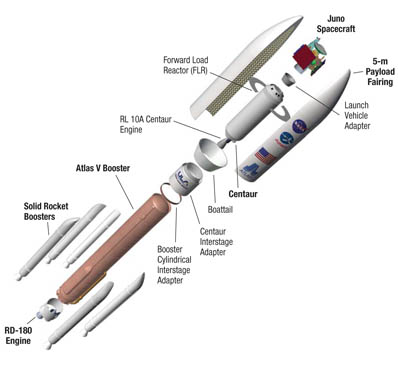With the recent retirement of the Space Shuttle behind us now, the 2nd half of 2011 will feature 5 unmanned NASA missions which run the gambit of all of their mission types (if one also includes their first mission of 2012). These missions will see a larger-than-normal media presence as well as NASA’s promotion of them to highlight what NASA is doing in the post-Shuttle era other than pay Russia millions of dollars to fly our astronauts to the ISS.
The first of these five missions is the
Juno mission to Jupiter. Juno is the second
New Frontiers mission (which is NASA’s medium funding level for planetary missions) and is a Jupiter polar orbiter. Juno will be the first spacecraft to orbit Jupiter in polar orbit (the
Ulysses probe made a polar slingshot of Jupiter to enter polar orbit of the Sun).
Galileo (NASA’s previous Jupiter orbiter) was an equatorial orbiter. Juno will also be the first spacecraft sent to Jupiter that is powered by solar arrays instead of a RTG due to the advances in the efficiency and economy of solar array technology which now make solar arrays available for Jupiter missions.

Juno will be launched by an
Atlas V rocket flying in the 551 configuration. The launch will occur from
Launch Complex 41 at the Cape Canaveral Air Force Station on 5 August 2011 at 11:34 to 12:43 EDT (15:34 to 16:43 UTC). Juno has a 22-day planetary launch window, with the next window opening in September 2012. This will be the second flight of the 551 configuration. The first was the first New Frontiers mission, the
New Horizons probe in January 2006, which is on its way to a flyby of Pluto and the
Kuiper Belt.
The 551 configuration, which is the most powerful Atlas V currently available, features five Aerojet strap-on solid motors (the maximum for the Atlas V), a Centaur second-stage with a single RL-10 engine, and a five-meter composite payload fairing that will cover the payload as well as enshroud the Centaur second-stage. The 551 is so powerful that the payload fairing jettison will occur before the first-stage burns out and is jettisoned (it literally speeds off the pad unlike the other less-powerful versions which gracefully rise off the pad).

Of particular note, this Atlas V (AV-029) is the last Atlas V that was transported to the launch site by Antonov An-124 heavy-lift aircraft. All future Atlas Vs will be transported by sea onboard the
Delta Mariner which until now was how the Delta IV made its way to the launch sites. United Launch Alliance is streamlining its operations and found it is cheaper now that both rockets are built in the same factory to also be transported to the launch site the same way.
The SRBs will burn-out 1 minute 23 seconds into flight, and two will drop away 10 seconds later, followed by the other three 1.5 seconds after. Payload fairing jettison is 3.5 minutes into flight, and the first stage cutoff is 4 minutes 26 seconds into flight. Centaur ignition is at 4 minutes 43 seconds into flight for a 6 minute burn to achieve a parking orbit. After a 30 minute coast, Centaur will ignite again for a 9 minute burn to place the spacecraft on an Earth escape trajectory. At 53 minutes 49 seconds into flight, Juno will separate from the Centaur to begin its five year journey to Jupiter.

On its journey to Jupiter, Juno will perform a
gravity-assist Earth flyby in 2013 before reaching Jupiter in July 2016. The spacecraft will place itself into a 11-day polar orbit and will make 33 orbits around Jupiter before the mission’s conclusion in October 2017 when the spacecraft will be intentionally de-orbited into Jupiter. But expect the mission to be extended, most NASA deep-space missions are:
Cassini (currently orbiting Saturn) has received two mission extensions, and Galileo received one mission extension before being de-orbited into Jupiter.
The Principal Investigator of the mission is Dr. Scott Bolton of the
Southwest Research Institute in San Antonio, Texas. The
Jet Propulsion Laboratory will manage the mission and Lockheed Martin built the spacecraft.
Links to the webcast will be posted closer to launch.
NOTE: Wikipedia links have been embedded into the text to help with comprehension.








